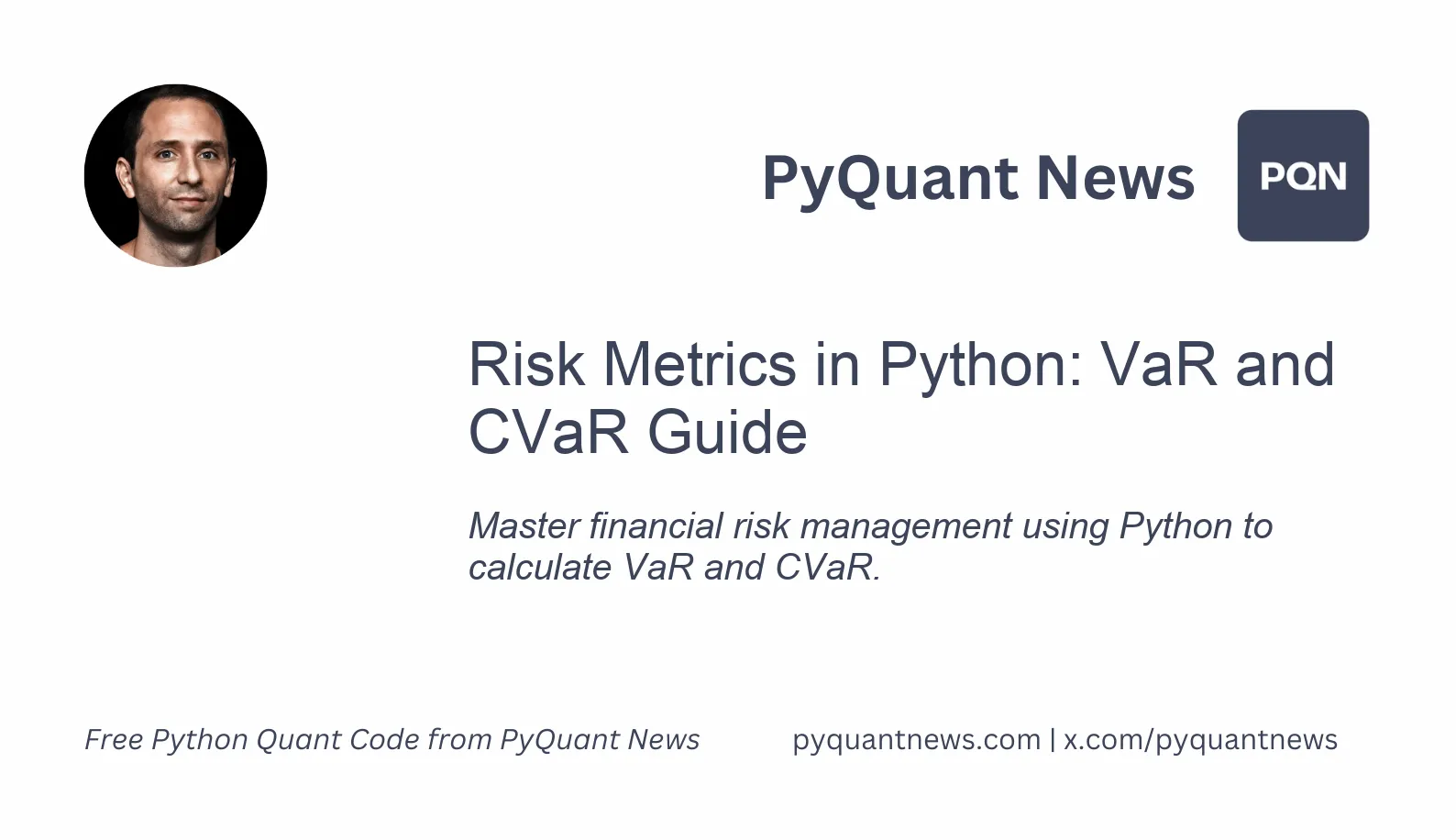Risk Metrics in Python: VaR and CVaR Guide






Risk Metrics in Python: VaR and CVaR Guide
In the ever-changing landscape of finance, managing risk is fundamental to achieving sustainable investment strategies. Python, with its robust computational tools, is increasingly indispensable for financial analysts and risk managers. This guide delves into calculating two pivotal risk metrics: Value at Risk (VaR) and Conditional Value at Risk (CVaR), using Python. By following this guide, you'll grasp their importance and learn how to implement them efficiently with Python.
Understanding Value at Risk (VaR)
What is VaR?
Value at Risk (VaR) quantifies the potential loss in value of a portfolio over a specified period for a given confidence interval. Essentially, it answers: "What is the maximum loss I can expect with a certain level of confidence over a specific time frame?"
Calculation Methods
- Historical Simulation: Uses historical market data to simulate potential losses.
- Variance-Covariance (Parametric) Method: Assumes that asset returns follow a normal distribution.
- Monte Carlo Simulation: Employs random sampling and statistical modeling to estimate potential losses.
Implementing VaR in Python
Let's walk through calculating VaR using the Historical Simulation method in Python.
Step 1: Import Necessary Libraries
import numpy as np
import pandas as pd
import matplotlib.pyplot as plt
Step 2: Load and Prepare Data
For this example, we'll use historical stock price data.
data = pd.read_csv('historical_stock_prices.csv', index_col='Date', parse_dates=True)
returns = data['Close'].pct_change().dropna()
Step 3: Calculate VaR
confidence_level = 0.95
var = np.percentile(returns, (1 - confidence_level) * 100)
print(f"Value at Risk (VaR) at {confidence_level*100}% confidence level is {var:.2%}")
Understanding Conditional Value at Risk (CVaR)
What is CVaR?
Conditional Value at Risk (CVaR), also known as Expected Shortfall, estimates the expected loss given that the loss has exceeded the VaR threshold. It offers a more detailed risk assessment by focusing on extreme losses.
Calculation Methods
- Historical Simulation: Similar to VaR but zeroes in on the average of losses beyond the VaR threshold.
- Variance-Covariance (Parametric) Method: Utilizes the normal distribution properties to estimate CVaR.
- Monte Carlo Simulation: Extends the Monte Carlo method used in VaR by averaging the tail losses.
Implementing CVaR in Python
We will calculate CVaR using the Historical Simulation method in Python.
Step 1: Identify Losses Beyond VaR
var_threshold = np.percentile(returns, (1 - confidence_level) * 100)
tail_losses = returns[returns < var_threshold]
Step 2: Calculate CVaR
cvar = tail_losses.mean()
print(f"Conditional Value at Risk (CVaR) at {confidence_level*100}% confidence level is {cvar:.2%}")
Visualizing VaR and CVaR
Visualization helps in understanding and communicating risk metrics. We'll use Matplotlib to visualize the distribution of returns and highlight VaR and CVaR.
plt.figure(figsize=(10, 6))
plt.hist(returns, bins=50, alpha=0.75, color='blue', edgecolor='black')
plt.axvline(x=var, color='red', linestyle='--', label=f'VaR ({confidence_level*100}%)')
plt.axvline(x=cvar, color='green', linestyle='--', label=f'CVaR ({confidence_level*100}%)')
plt.title('Distribution of Returns with VaR and CVaR')
plt.xlabel('Returns')
plt.ylabel('Frequency')
plt.legend()
plt.show()
Practical Applications and Limitations
Applications
- Portfolio Management: VaR and CVaR are used to gauge portfolio risk and make informed decisions.
- Risk Assessment: Financial institutions leverage these metrics for regulatory reporting and risk evaluation.
- Stress Testing: VaR and CVaR are crucial in stress testing scenarios to analyze portfolio performance under extreme conditions.
Limitations
- Assumptions: The reliability of VaR and CVaR heavily depends on the assumptions of normal distribution and historical data.
- Market Conditions: These metrics might not account for sudden market changes or rare, unpredictable events.
- Static Nature: VaR and CVaR are static measures and might not capture dynamic market behaviors.
Resources for Further Learning
- Books:
- "Value at Risk: The New Benchmark for Managing Financial Risk" by Philippe Jorion. This book provides a comprehensive introduction to VaR.
- "Quantitative Risk Management: Concepts, Techniques, and Tools" by Alexander J. McNeil, Rüdiger Frey, and Paul Embrechts. It covers advanced risk management techniques and tools.
- Online Courses:
- Coursera offers a course titled "Financial Risk Management with R and Python," which delves into these metrics.
- Udemy has a wide range of Python for Finance courses that cover risk management.
- Research Papers:
- "A Comprehensive Review of Value at Risk Methodologies" by Angelini, Monfrini, and Riani. This paper reviews various VaR methodologies.
- "Conditional Value-at-Risk for General Loss Distributions" by Rockafellar and Uryasev. This paper explores CVaR for different loss distributions.
- Python Libraries:
- The
QuantLiblibrary is a comprehensive library for quantitative finance in Python. PyPortfolioOptis an excellent library for portfolio optimization and risk management.
- The
Conclusion
Calculating risk metrics such as Value at Risk (VaR) and Conditional Value at Risk (CVaR) is vital for effective financial risk management. With Python's powerful libraries and computational capabilities, implementing these metrics has never been more straightforward. By mastering these concepts, financial analysts and risk managers can make more informed decisions, ensuring a robust risk management strategy.
Whether you're a seasoned professional or a curious learner, the resources mentioned above will provide you with a deeper understanding and practical knowledge of risk management in finance. Embrace the power of Python and elevate your risk management skills to the next level.